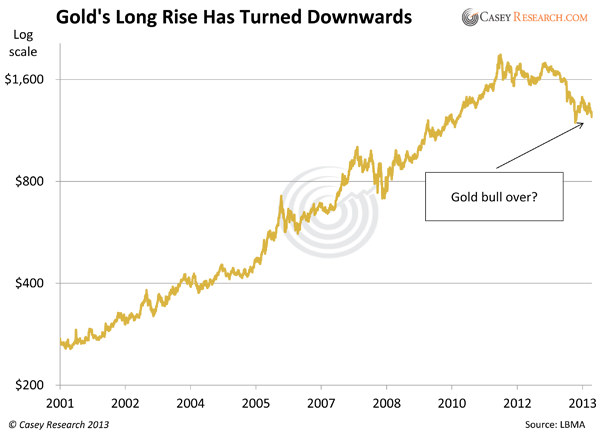Gold & Precious Metals
“People think I have a problem with entitlement programs. I don’t. I have a problem with the sustainability of entitlement programs.”
Stan Druckenmiller on Charlie Rose.
Click here to view the video.
Robert Levy
Border Gold Corp.
www.bordergold.com | 1.888.312.2288
www.bordergold.com
“Our main format is now video analysis…”
Here are today’s videos:
Gold Cost Of Production & Money Flow Charts
Silver Mystery Money Flows Chart
US T-Bond Technical Failure Chart
HUI (Gold Stocks Index) Rising Histograms Chart
Thanks,
Morris
Unique Introduction For Web Readers: Send me an email to alerts@superforcesignals.com and I’ll send you 3 of my next
Super Force Surge Signals free of charge, as I send them to paid
subscribers. Thank you!
The Super Force Proprietary SURGE index SIGNALS:
25 Super Force Buy or 25 Super Force Sell: Solid Power.
50 Super Force Buy or 50 Super Force Sell: Stronger Power.
75 Super Force Buy or 75 Super Force Sell: Maximum Power.
100 Super Force Buy or 100 Super Force
Sell: “Over the Top” Power.
Stay alert for our Super Force alerts, sent by email to subscribers, for both the daily charts on Super Force Signals atwww.superforcesignals.com and for the 60 minute charts at www.superforce60.com
About Super Force Signals:
Our Super Force signals are created thru our proprietary blend of the highest quality technical analysis and many years of successful business building. We are two business owners with excellent synergy. We understand risk and reward. Our subscribers are generally successful business owners, people like yourself with speculative funds, looking for serious management of your risk and reward in the market.
Frank Johnson: Executive Editor, Macro Risk Manager.
Morris Hubbartt: Chief Market Analyst, Trading Risk Specialist.
Email:
Mail:
SFS Web Services
1170 Bay Street, Suite #143
Toronto, Ontario, M5S 2B4
Canada
Time for Goldbugs to Admit Defeat?
Posted by Jeff Clark, Senior Precious Metals Analyst
on Thursday, 5 December 2013 19:33
After a 12-year run, it looks like gold’s wave has truly crested, and many bears are arguing that it’s all downhill from here. A quick glance at a long-term gold price chart can certainly seem to confirm this impression.

Gold’s price has fallen by more than a third since its 2011 high. The downturn exceeds the 2008 waterfall selloff. Many technical analysts are saying that the “damage” on the charts is too great for gold to recover. The rout is so bad, even hardened goldbugs have grown quiet lately.
Is it time for gold investors to admit defeat?
Well, if it were true that “damage” on a chart such as we’ve seen signals the end of a bull market, perhaps it might be. But is it so? Or is this just a correction?
One of the greatest bull markets in modern times was the Nasdaq in the 1990s. The Nasdaq composite rose a whopping 1,150% over the span of a decade. But did you know it had a major correction in the middle of that run? The same is true of oil’s big surge in the mid-2000s. Consider this chart of the big corrections oil and the Nasdaq experienced:

After seeing prices crash in both the Nasdaq and oil, most investors assumed those bull markets were over—but they weren’t. Here’s the subsequent rise in each after prices bottomed:

The Nasdaq and oil did recover from their large corrections—despite all the technical “damage” many pointed to as proof that those bull markets were over. Investors who sold their positions during the downdrafts missed out on some fantastic profits.
Given that all the reasons gold rose from 2001 to 2011 are still in force, I am convinced gold’s current correction is the setup for a second big surge—and, ultimately, a true gold mania of historic proportions.
Just because gold doesn’t seem to be reacting to Fed money-printing at the moment doesn’t mean it won’t. Sooner or later, reality trumps fantasy. Reason says that you can’t quintuple your balance sheet in five years and expect no repercussions. The Fed keeps hinting it will taper its money printing, but it still has not. We’ve had QE1, QE2, Operation Twist, and now QE3… none of them has worked, and the new Fed chair wants to print even more money.
It’s pure fantasy to believe there will be no consequences to these actions—and the reality is that whatever else happens, gold will react positively.
Should gold investors admit defeat? I say it’s reckless central bankers who should declare defeat.
A gold recovery is inevitable. Prepare accordingly. Try BIG GOLD risk-free for 3 months to access our GLD put strategy, frequent bullion discounts, and the producers that will respond the strongest once the recovery takes hold. 100% satisfaction, or your money back—click here to get started.
Having replaced savings with debt on both the national and individual levels, I think it’s well past time for Westerners to take a few lessons from our creditors in the East. Many Americans consider gold a “barbarous relic,” but in Asia, the yellow metal remains the bedrock of individual savings plans. This means that either greater than half of the world’s population are barbarians, or they’ve held onto an important tradition that our culture has forgotten.
A Culture of Gold
One of the most important elements of Eastern gold demand is that it is not limited to educated investors or the higher classes, as often seems to be the case in the West. Throughout Asia, no matter one’s social status, precious metals are the first assets people choose to protect their wealth. There is not even a glimmer of doubt about the enduring value of hard money.
A recent Bloomberg article quotes a Chinese woman, “I don’t know anything about the stock market and I don’t have enough money to buy property, so I figured gold is the safest choice.”
Some might write off this philosophy as naïve, but her logic is founded in centuries of tradition, borne of hard-won experience. The same goes in India and across South Asia, where gold is an essential part of local religious customs. From wedding dowries to temple offerings, gold carries a caché in Asia that most Westerners can’t fathom.
Consider the US as a comparison. Here, newlyweds are more likely to receive a house full of fancy appliances than any assets that might form the foundation of long-term financial independence.
After a couple of generations of US-dollar dominance, Americans have become lazy with our wealth. While we exploit our economic power by going into debt for fancy cars, big-screen TVs, and expensive smart phones, our creditors are steadily stockpiling gold.
A River of Gold from West to East
Asia’s love affair with gold became worldwide news when the price of the yellow metal dropped last April. Asian consumers saw the price drop as a fortunate buying opportunity, and metals dealers were swamped with orders for both bullion and jewelry. Premiums skyrocketed across the continent, but this did not slow demand.
With all this demand, shouldn’t gold’s global spot price have continued rising? Unfortunately, many Westerners were selling into the Eastern demand. In fact, the stagnant spot price concealed a historic transfer of real wealth.
The rising price of gold over the past decade had lured many Western investors into the paper gold market through precious metals exchange-traded funds (ETFs). To ETF investors intent on fast growth rather than long-term capital preservation, the recent drop in price was viewed as a sell signal, not an opportunity.
By the end of September, gold ETFs had sold off about 700 metric tons of physical gold – more than half of it in just the second quarter. The World Gold Council reports that the majority of these outflows have been absorbed by Asian demand.
However, Western selling was enough to keep the global spot price from recovering. Instead of more capital flowing into gold, it was the gold itself which was flowing from Western financial institutions to Eastern households.
The latest data shows that consumer demand for physical gold in the first three quarters of 2013 hit a historical record of 2,896.5 metric tons. 90% of the year-over-year increase in this demand came from Asia and the Middle East.
Meanwhile, Americans have been distracted by one record high after another in the domestic stock market.
Governments Intervene
When reporting on Asian gold demand, the Western media tends to focus on nations like India, which has practically declared war against gold buyers this year in a misguided attempt to curb its trade deficit.
The Indian government raised tariffs on the metal to a record 10%, and now requires importers to re-export 20% of their gold. India’s central bank even went as far as asking temples around the country to divulge how much gold they were storing, though many refused.
Thailand and Vietnam have taken similar steps to subdue their populations’ gold demand, even though the primary outcome has been to increase gold smuggling.
These governments’ measures have received the most attention because they fit nicely into the Western narrative that gold is an old-fashioned asset that does more harm than good in modern economies. But the truth is that the only ones harmed by gold are Western governments!
China Rising
Last month, China officially surpassed India as the world’s largest consumer of gold. Unlike New Delhi, Beijing is encouraging its citizens’ gold lust by easing restrictions on the gold trade. The People’s Bank of China (PBOC) is preparing to expand the number of businesses allowed to import and export gold on a large scale. It has also increased the amount of tax-free gold citizens are allowed to bring into the country.
Meanwhile, China is finally pulling away from the US dollar. A month after China’s government news agency called for a “de-Americanized world,” a deputy governor at the PBOC said, “It’s no longer in China’s favor to accumulate foreign-exchange reserves.”
Simply put, China is planning to wind down its own stimulus program of buying US dollars, and instead allow the value of the yuan to appreciate. In preparation for this shift, China has been diversifying its foreign exchange reserves into gold. The PBOC has not released official numbers on its gold reserves since 2009, but experts have begun to speculate that its current holdings are far larger than previously estimated.
A Rude Awakening
This is the time when the West realizes that its great reservoir of wealth has run dry, as the gold has all flowed East.
When China stops buying US Treasuries, the Fed will remain the only major buyer of US debt. This will drive interest rates up, thereby sticking the US government with obligations it cannot possibly fulfill. Ultimately, this will be the death knell for the dollar, as the Fed will be forced to significantly expand its QE program to assume the role as Treasury-buyer of last resort.
Mom-and-pop gold buyers throughout the East probably do not understand all the subtleties of the foreign exchange markets, but an undying appreciation for gold is built into their culture. Make no mistake: the East is the engine of the 21st century global economy – and it is riding on rails of gold.
This holiday season, consider breaking with our recent Western tradition of giving gifts of no enduring value. Instead, take the opportunity to turn some of your paper dollars into gifts that will still have value when your kids are grown.
Peter Schiff is Chairman of Euro Pacific Precious Metals, a gold and silver dealer selling reputable, well-known bullion coins and bars at competitive prices.
Click here for a free subscription to Peter Schiff’s Gold Letter, a monthly newsletter featuring the latest gold and silver market analysis from Peter Schiff, Casey Research, and other leading experts.
And now, investors can stay up-to-the-minute on precious metals news and Peter’s latest thoughts by visiting Peter Schiff’s Official Gold Blog.
My trading partner JW and I had a great talk the other day which spurred to the creation of this interesting and educational gold trading article we wanted to share with you.
Read Article Here: http://www.thegoldandoilguy.com/articles/fundamentals-for-gold-futures/
Chris Vermeulen
TheGoldAndOilGuy.com
-
I know Mike is a very solid investor and respect his opinions very much. So if he says pay attention to this or that - I will.
~ Dale G.
-
I've started managing my own investments so view Michael's site as a one-stop shop from which to get information and perspectives.
~ Dave E.
-
Michael offers easy reading, honest, common sense information that anyone can use in a practical manner.
~ der_al.
-
A sane voice in a scrambled investment world.
~ Ed R.
Inside Edge Pro Contributors

Greg Weldon

Josef Schachter

Tyler Bollhorn

Ryan Irvine

Paul Beattie

Martin Straith

Patrick Ceresna

Mark Leibovit

James Thorne

Victor Adair



